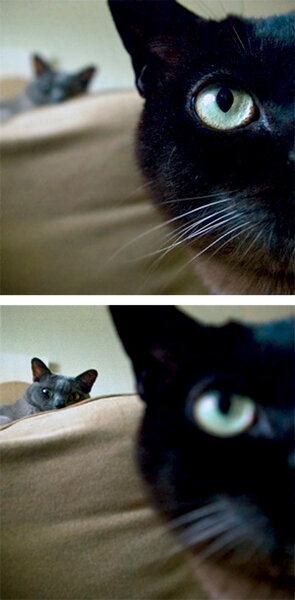Lytro cameras: Focus pictures after you take them
Loading...
For more than a century, photography has required three steps: Point. Focus. Shoot.
But a new camera debuting early next year could rewrite that order: Point. Shoot. Focus.
Silicon Valley start-up Lytro has introduced the first commercially available "light field" camera, a technology that allows people to focus images after the picture has been taken.
Instead of dealing in megapixels, Lytro measures its cameras in megarays, or how many rays of light it captures with each snapshot. By pulling in information from the entire scene – including the intensity and angle of up to 11 million rays of light – Lytro cameras can focus on any object within the frame seconds or days after the shutter snapped.
"It represents a really big shift in cameras – in capturing an entirely new kind of data," says Ren Ng, Lytro's founder and chief executive.
The camera resembles a stick of butter, but with a lens on one end and a viewfinder on the other. After clicking the shutter button, photographers can play with the focus right on the camera or move the files over to a computer for more careful tweaking.
But Lytro believes that finding the perfect focus shouldn't be a single-player game. Lytro images can be shared across Facebook, personal websites, and mobile phones – with all the focusing tools built into each photo. Viewers may click through the scene, sharpening or revealing objects once hidden in the blurry background. The photos become interactive.
For example, one Lytro photo begins as a crisply focused shot of an etched window. But clicking on the panes of glass reveals the city scene outside. Pedestrians, cars, and streetlights, once obscured by the tight focus, now come into view. (You can find this and other examples at Lytro.com.)
Richard Koci Hernandez, who took that city picture and is a professor of new media at the University of California, Berkeley, admits that the concept of light-field photography took some time to set in.
"My jaw hit the floor," says Mr. Hernandez, a former photojournalist who got early access to a Lytro camera but is otherwise unaffiliated with the company. "My first thought was that this was some kind of game-changing technology. That term is thrown around a lot. A 3-D camera is a cool novelty, but I don't think 3-D technology will have a real effect on everyday photography. This could."
Like many gee-whiz technologies, light-field cameras have existed in laboratories for more than 15 years. But instead of fitting in your pocket, the original designs used wall-sized arrays of cameras connected to a supercomputer. Mr. Ng figured out a way to miniaturize the whole process, explains Stanford University Prof. Pat Hanrahan, his doctoral thesis adviser.
While all digital cameras have light sensors, Lytro lines its sensors with a layer of microlenses, allowing the device to catalog each ray. Software then combs through the millions of rays, determining which parts will stitch together into a single, in-focus image.
Lytro cameras can be pre-ordered through the firm's website, with the release date set for "early next year," says Ng. The $399 base model holds up to 350 images. A $499 version has double the storage.
"If I had to make a choice, I probably wouldn't just rely on a Lytro camera," says Hernandez. The camera isn't designed for low-light conditions, he says, the resolution is about on par with today's average point-and-shoot cameras, "and it doesn't really prove itself if there isn't a foreground and a background."
"But the beauty for me, as with all gadgets, is that it's so small," says Hernandez. There's no need to tote around his expensive digital cameras for everyday photos. "I have my iPhone and I have my Lytro."
For more on how technology intersects daily life, follow Chris on Twitter @venturenaut.






